2023 SUBARU BRZ winter tires
[x] Cancel search: winter tiresPage 253 of 432

Vehicle Stability Control (VSC)/TRAC System
247
Starting and Operating7
– CONTINUED –
7-13. Vehicle Stability Control (VSC)/TRAC System■Vehicle Stability Control
(VSC) SystemIn the event of wheelspin and/or skidding
on a slippery road surface and/or during
cornering and/or an evasive maneuver,
the Vehicle Stability Control (VSC) system
adjusts the engine’s output and the
wheels’ respective braking forces to help
maintain traction and directional control.
The skid suppression function is designed
to help maintain directional stability by
suppressing the wheels’ tendency to slide
sideways during steering operations. Acti-
vation of this function is indicated by
flashing of the Vehicle Stability Control
(VSC) operation indicator light.NOTE In the following circumstances, the
vehicle may be less stable than it feels
to the driver. The Vehicle Stability
Control (VSC) system may therefore
operate. Such operation does not indi-
cate a system malfunction. - On gravel-covered or rutted
roads
- On unfinished roads
- When the vehicle is fitted with
snow tires or winter tires
Activation of the Vehicle Stability
Control (VSC) system will cause opera-
tion of the steering wheel to feel
slightly different compared to that for
normal conditions.
It is always important to reduce
speed when approaching a corner,
even if the vehicle is equipped with
Vehicle Stability Control (VSC) system.
Always turn off the engine before
replacing a tire as failure to do so may
render the Vehicle Stability Control
(VSC) system unable to operate
correctly.
■ TRAC SystemThe TRAC system is designed to prevent
spinning of the driving wheels on slippery
road surfaces, thereby helping to maintain
traction and directional control. Activation
of this function is indicated by flashing of
the Vehicle Stability Control (VSC) opera-
tion indicator light. The TRAC system is
also equipped with the brake LSD func-
tion.
WARNING
Directional control and power
may not be achievable while
driving on slippery road surfaces,
even if the TRAC system is oper-
ating. Do not drive the vehicle in
conditions where stability and
power may be lost. Always use the utmost care in
driving – overconfidence
because you are driving with a
Vehicle Stability Control (VSC)
system and TRAC system
equipped vehicle could easily
lead to a serious accident.
CAUTION
Even if your vehicle is equipped
with Vehicle Stability Control
(VSC) system and TRAC system,
winter tires should be used when
driving on snow-covered or icy
roads; in addition, vehicle speed
should be reduced considerably.
Simply having a Vehicle Stability
Control (VSC) system and TRAC
system does not guarantee that
the vehicle will be able to avoid
accidents in any situation.
BRZ_U.book 247 ページ 2022年3月29日 火曜日 午後3時59分
Page 295 of 432
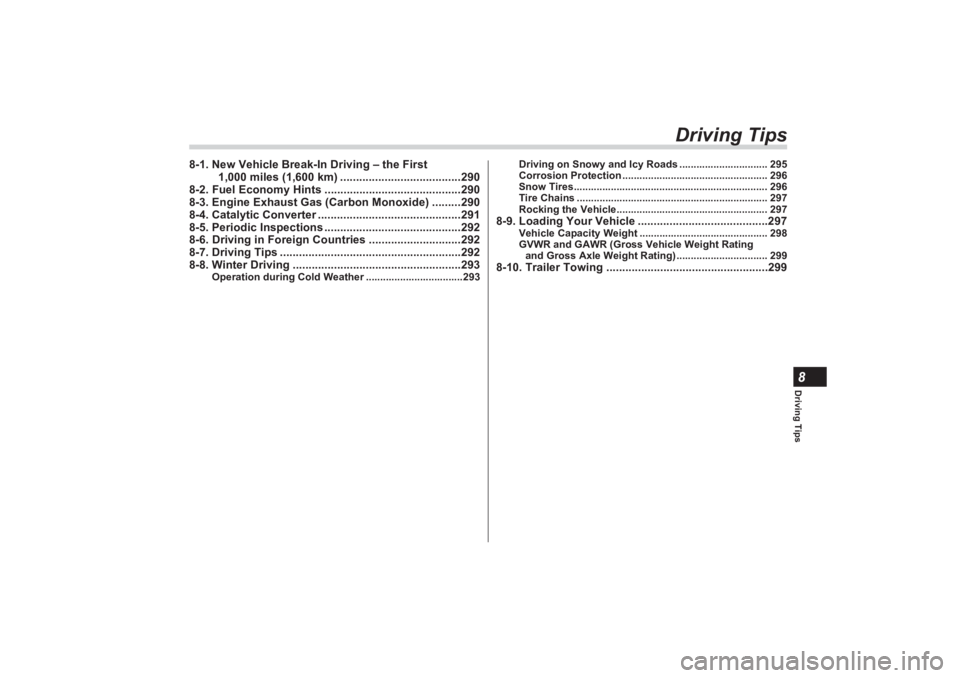
Driving Tips8
Driving Tips
8-1. New Vehicle Break-In Driving – the First
1,000 miles (1,600 km) ......................................290
8-2. Fuel Economy Hints ...................... .....................290
8-3. Engine Exhaust Gas (Carbon Monoxide) .........290
8-4. Catalytic Converter .............................................291
8-5. Periodic Inspections ...........................................292
8-6. Driving in Foreign Coun tries .............................292
8-7. Driving Tips .........................................................292
8-8. Winter Driving .....................................................293
Operation during Cold Weather ..................................293 Driving on Snowy and Icy Roads ............................... 295
Corrosion Protection ................................................... 296
Snow Tires.................................................................... 296
Tire Chains ................................................................... 297
Rocking the Vehicle..................................................... 297
8-9. Loading Your Vehicle .........................................297
Vehicle Capacity Weight ............................................. 298
GVWR and GAWR (Gross Vehicle Weight Rating
and Gross Axle Weight Rating) ................................ 299
8-10. Trailer Towing ...................................................299
BRZ_U.book 289 ページ 2022年3月29日 火曜日 午後3時59分
Page 299 of 432
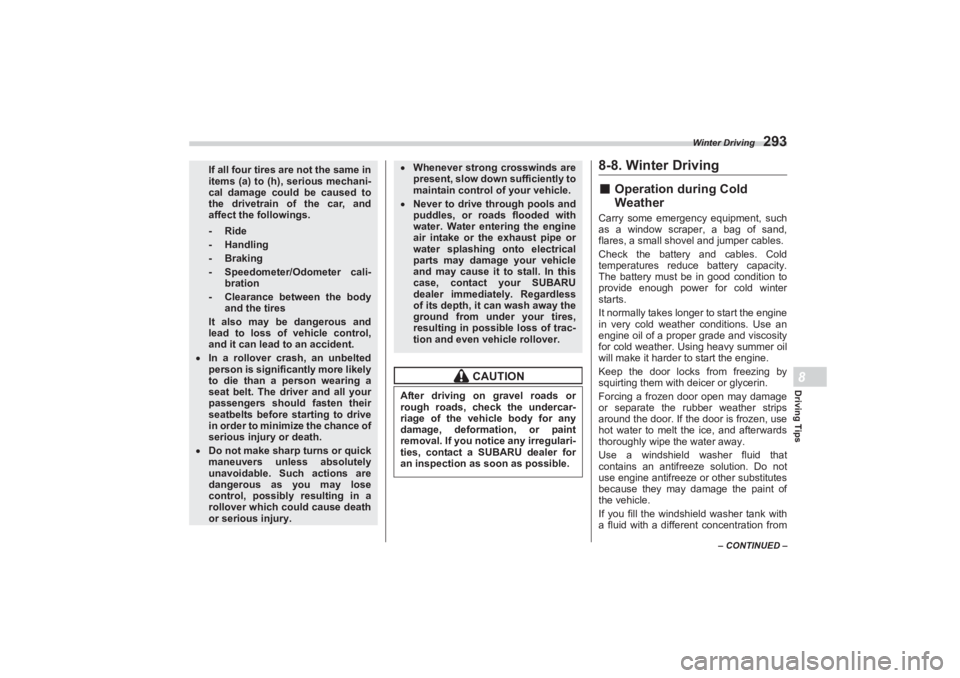
Winter Driving
293
Driving Tips8
– CONTINUED –
8-8. Winter Driving■Operation during Cold
WeatherCarry some emergency equipment, such
as a window scraper, a bag of sand,
flares, a small shovel and jumper cables.
Check the battery and cables. Cold
temperatures reduce battery capacity.
The battery must be in good condition to
provide enough power for cold winter
starts.
It normally takes longer to start the engine
in very cold weather conditions. Use an
engine oil of a proper grade and viscosity
for cold weather. Using heavy summer oil
will make it harder to start the engine.
Keep the door locks from freezing by
squirting them with deicer or glycerin.
Forcing a frozen door open may damage
or separate the rubber weather strips
around the door. If the door is frozen, use
hot water to melt the ice, and afterwards
thoroughly wipe the water away.
Use a windshield washer fluid that
contains an antifr eeze solution. Do not
use engine antifreeze or other substitutes
because they may damage the paint of
the vehicle.
If you fill the windshield washer tank with
a fluid with a different concentration from
If all four tires are not the same in
items (a) to (h), serious mechani-
cal damage could be caused to
the drivetrain of the car, and
affect the followings.-Ride-Handling- Braking- Speedometer/Odometer cali-
bration- Clearance between the body
and the tires
It also may be dangerous and
lead to loss of vehicle control,
and it can lead to an accident.
In a rollover crash, an unbelted
person is significantly more likely
to die than a person wearing a
seat belt. The driver and all your
passengers should fasten their
seatbelts before st arting to drive
in order to minimize the chance of
serious injury or death. Do not make sharp turns or quick
maneuvers unless absolutely
unavoidable. Such actions are
dangerous as you may lose
control, possibly resulting in a
rollover which could cause death
or serious injury.
Whenever strong crosswinds are
present, slow do wn sufficiently to
maintain control of your vehicle. Never to drive through pools and
puddles, or roads flooded with
water. Water entering the engine
air intake or the exhaust pipe or
water splashing onto electrical
parts may damage your vehicle
and may cause it to stall. In this
case, contact your SUBARU
dealer immediat ely. Regardless
of its depth, it can wash away the
ground from under your tires,
resulting in possible loss of trac-
tion and even vehicle rollover.
CAUTION
After driving on gravel roads or
rough roads, check the undercar-
riage of the vehicle body for any
damage, deformation, or paint
removal. If you notice any irregulari-
ties, contact a SUBARU dealer for
an inspection as soon as possible.
BRZ_U.book 293 ページ 2022年3月29日 火曜日 午後3時59分
Page 301 of 432
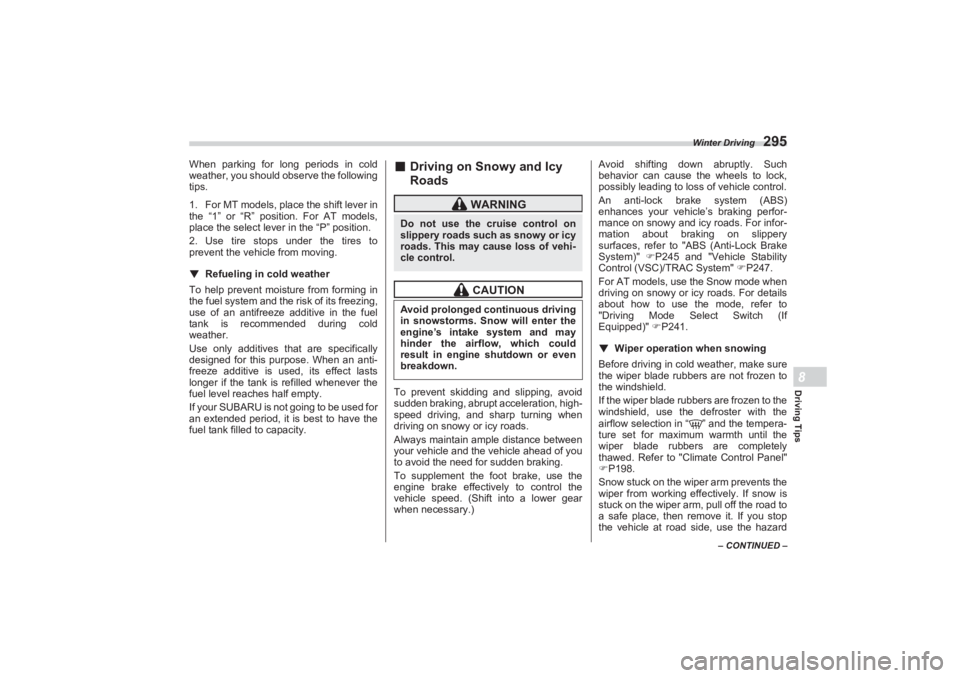
Winter Driving
295
Driving Tips8
– CONTINUED –
When parking for long periods in cold
weather, you should observe the following
tips.
1. For MT models, place the shift lever in
the “1” or “R” position. For AT models,
place the select lever in the “P” position.
2. Use tire stops under the tires to
prevent the vehicle from moving.▼ Refueling in cold weather
To help prevent moisture from forming in
the fuel system and t he risk of its freezing,
use of an antifreeze additive in the fuel
tank is recommended during cold
weather.
Use only additives that are specifically
designed for this purpose. When an anti-
freeze additive is used, its effect lasts
longer if the tank is refilled whenever the
fuel level reaches half empty.
If your SUBARU is not going to be used for
an extended period, it is best to have the
fuel tank filled to capacity.
■ Driving on Snowy and Icy
RoadsTo prevent skidding and slipping, avoid
sudden braking, abrupt acceleration, high-
speed driving, and sharp turning when
driving on snowy or icy roads.
Always maintain ample distance between
your vehicle and the vehicle ahead of you
to avoid the need for sudden braking.
To supplement the foot brake, use the
engine brake effectively to control the
vehicle speed. (Shift into a lower gear
when necessary.) Avoid shifting down abruptly. Such
behavior can cause the wheels to lock,
possibly leading to loss of vehicle control.
An anti-lock brake system (ABS)
enhances your vehicle’s braking perfor-
mance on snowy and icy roads. For infor-
mation about braking on slippery
surfaces, refer to "ABS (Anti-Lock Brake
System)" P245 and "Vehicle Stability
Control (VSC)/TRAC System" P247.
For AT models, use the Snow mode when
driving on snowy or icy roads. For details
about how to use the mode, refer to
"Driving Mode Select Switch (If
Equipped)" P241.
▼ Wiper operation when snowing
Before driving in cold weather, make sure
the wiper blade rubbers are not frozen to
the windshield.
If the wiper blade rubbers are frozen to the
windshield, use the defroster with the
airflow selection in “ ” and the tempera-
ture set for maximum warmth until the
wiper blade rubbers are completely
thawed. Refer to "Cli mate Control Panel"
P198.
Snow stuck on the wiper arm prevents the
wiper from working effectively. If snow is
stuck on the wiper arm, pull off the road to
a safe place, then remove it. If you stop
the vehicle at road side, use the hazard
WARNING
Do not use the cruise control on
slippery roads such as snowy or icy
roads. This may cause loss of vehi-
cle control.
CAUTION
Avoid prolonged continuous driving
in snowstorms. Snow will enter the
engine’s intake system and may
hinder the airflow, which could
result in engine shutdown or even
breakdown.
BRZ_U.book 295 ページ 2022年3月29日 火曜日 午後3時59分
Page 302 of 432
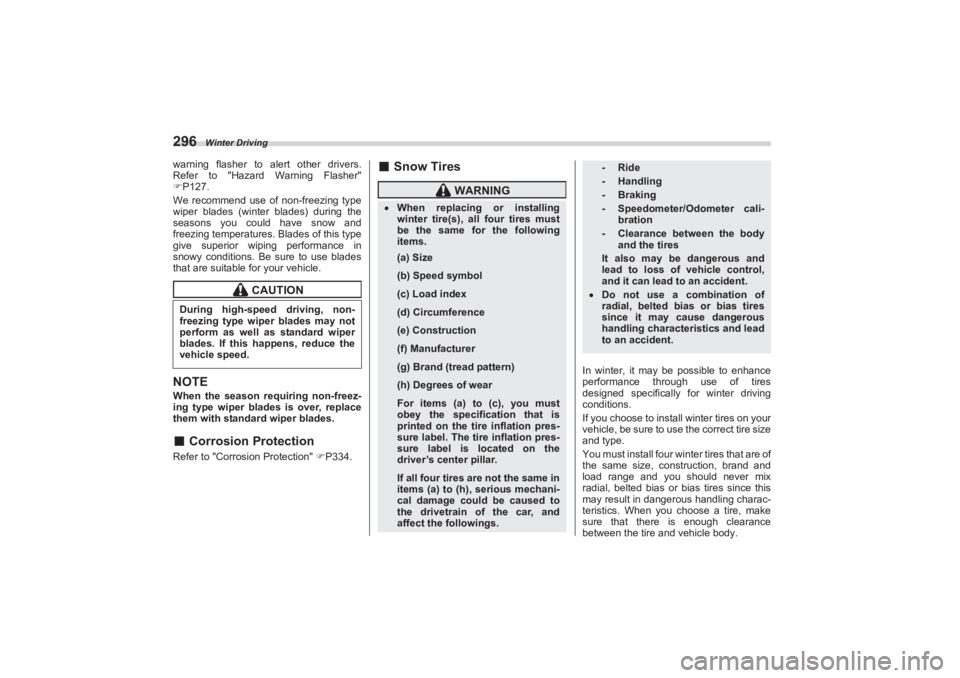
Winter Driving
296warning flasher to alert other drivers.
Refer to "Hazard Warning Flasher"
P127.
We recommend use of non-freezing type
wiper blades (winter blades) during the
seasons you could have snow and
freezing temperatures. Blades of this type
give superior wiping performance in
snowy conditions. Be sure to use blades
that are suitable for your vehicle.NOTEWhen the season requiring non-freez-
ing type wiper blades is over, replace
them with standard wiper blades.■ Corrosion ProtectionRefer to "Corrosion Protection" P334.
■ Snow Tires
In winter, it may be possible to enhance
performance through use of tires
designed specifically for winter driving
conditions.
If you choose to install winter tires on your
vehicle, be sure to use the correct tire size
and type.
You must install four winter tires that are of
the same size, construction, brand and
load range and you should never mix
radial, belted bias or bias tires since this
may result in dangerous handling charac-
teristics. When you choose a tire, make
sure that there is enough clearance
between the tire and vehicle body.
CAUTION
During high-speed driving, non-
freezing type wiper blades may not
perform as well as standard wiper
blades. If this happens, reduce the
vehicle speed.
WARNING
When replacing or installing
winter tire(s), all four tires must
be the same for the following
items.
(a) Size(b) Speed symbol(c) Load index(d) Circumference(e) Construction(f) Manufacturer(g) Brand (tread pattern)(h) Degrees of wearFor items (a) to (c), you must
obey the specification that is
printed on the tire inflation pres-
sure label. The ti re inflation pres-
sure label is located on the
driver’s center pillar.If all four tires are not the same in
items (a) to (h), serious mechani-
cal damage could be caused to
the drivetrain of the car, and
affect the followings.
-Ride-Handling- Braking- Speedometer/Odometer cali-
bration- Clearance between the body
and the tires
It also may be dangerous and
lead to loss of vehicle control,
and it can lead to an accident.
Do not use a combination of
radial, belted bias or bias tires
since it may cause dangerous
handling characteristics and lead
to an accident.
BRZ_U.book 296 ページ 2022年3月29日 火曜日 午後3時59分
Page 364 of 432

Tires and Wheels
35811-21. Tires and Wheels■Types of TiresYou should be familiar with type of tires
present on your vehicle.
▼ Summer tires
The factory-installed tires on your new
vehicle are summer tires.
Summer tires are high-speed capability
tires best suited for highway driving under
dry conditions.
Summer tires are inadequate for driving
on slippery roads such as on snow-
covered or icy roads.
If you drive your vehicle on snow-covered
or icy roads, we strongly recommend the
use of winter (snow) tires.
When installing winter tires, be sure to
replace all four tires.
▼ All season tires
All season tires are designed to provide
an adequate measure of traction, handling
and braking performance in year-round
driving including snowy and icy road
conditions. However all season tires do
not offer as much traction performance as
winter (snow) tires in heavy or loose snow
or on icy roads. All season tires are identified by “ALL
SEASON” and/or “M+S” (Mud & Snow) on
the tire sidewall.
▼ Winter (snow) tires
Winter tires are best suited for driving on
snow-covered and icy roads. However
winter tires do not perform as well as
summer tires and all season tires on roads
other than snow-covered and icy roads.
NOTEIf the tread wears down below 0.16 in.
(4mm) on snow tires the effectiveness
of snow tires is lost.
▼ Low profile tires
Generally, low profile tires will wear more
rapidly and tire grip performance will be
reduced on snowy and/or icy roads when
compared to standard tires. Be sure to
use snow tires or tire chains on snowy
and/or icy roads and drive carefully at a
speed appropriate for road and weather
conditions.NOTELow profile tires may cause greater
damage than usual to the wheel when
receiving impact from the road sur-
face. Therefore pay attention to the fol-
lowing:
Be sure to use proper tire inflation
pressure. If tires are under-inflated,
they may be damaged more severely.
Avoid pot holes, uneven pavement,
curbs and other road hazards. Failure
to do so may lead to severe tire and
wheel damage.
■ Tire Pressure Monitoring
System (TPMS) (If Equipped)The tire pressure monitoring system
provides the driver with a warning
message by sending a signal from a
sensor that is installed in each wheel
when tire pressure is severely low. The
tire pressure monitoring system will acti-
vate only when the vehicle is driven. Also,
this system may not react immediately to
a sudden drop in tire pressure (for
example, a blow-out caused by running
over a sharp object).
If you adjust the tire pressures in a warm
garage and will then drive the vehicle in
cold outside air, the resulting drop in tire
pressures may cause the low tire pressure
warning light to illuminate. To avoid this
problem when adjusting the tire pressures
in a warm garage, inflate the tires to pres-
sures higher than those shown on the tire
inflation pressure label. Specifically,
inflate them by an extra 1 psi (6.9 kPa,
0.07 kgf/cm
2) for every difference of 10°F
BRZ_U.book 358 ページ 2022年3月29日 火曜日 午後3時59分
Page 372 of 432
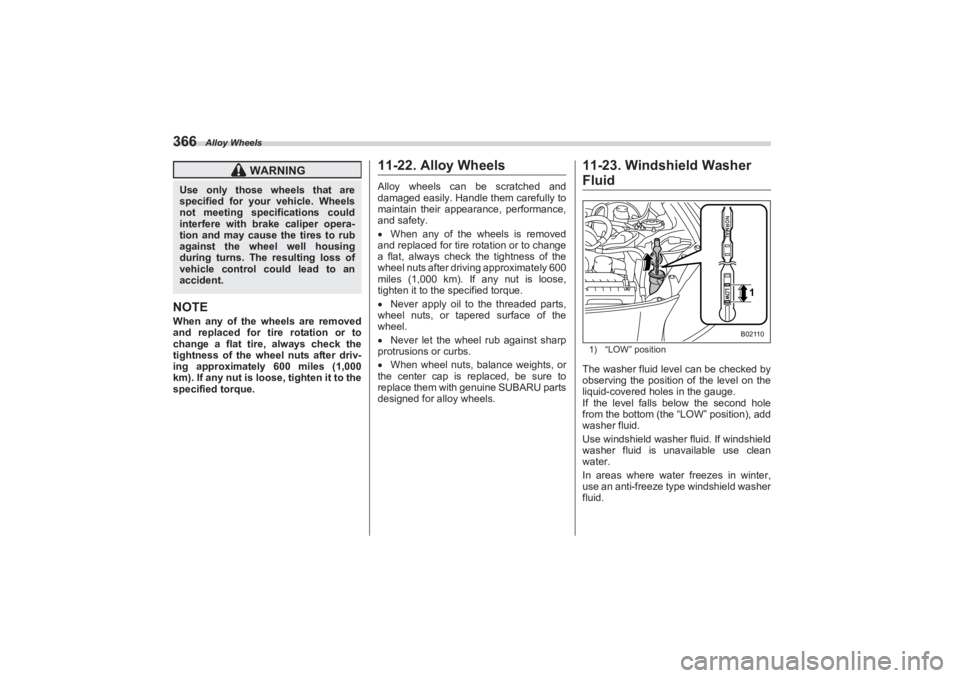
Alloy Wheels
366NOTEWhen any of the wheels are removed
and replaced for tire rotation or to
change a flat tire, always check the
tightness of the wheel nuts after driv-
ing approximately 600 miles (1,000
km). If any nut is loos e, tighten it to the
specified torque.
11-22. Alloy WheelsAlloy wheels can be scratched and
damaged easily. Handle them carefully to
maintain their appearance, performance,
and safety.
When any of the wheels is removed
and replaced for tire rotation or to change
a flat, always check the tightness of the
wheel nuts after driving approximately 600
miles (1,000 km). If any nut is loose,
tighten it to the specified torque.
Never apply oil to the threaded parts,
wheel nuts, or tapered surface of the
wheel.
Never let the wheel rub against sharp
protrusions or curbs.
When wheel nuts, balance weights, or
the center cap is replaced, be sure to
replace them with genuine SUBARU parts
designed for alloy wheels.
11-23. Windshield Washer Fluid1) “LOW” positionThe washer fluid level can be checked by
observing the position of the level on the
liquid-covered holes in the gauge.
If the level falls below the second hole
from the bottom (the “LOW” position), add
washer fluid.
Use windshield washer fluid. If windshield
washer fluid is unavailable use clean
water.
In areas where water freezes in winter,
use an anti-freeze type windshield washer
fluid.
WARNING
Use only those wheels that are
specified for your vehicle. Wheels
not meeting specifications could
interfere with brake caliper opera-
tion and may cause the tires to rub
against the wheel well housing
during turns. The resulting loss of
vehicle control could lead to an
accident.
1B02110
BRZ_U.book 366 ページ 2022年3月29日 火曜日 午後3時59分
Page 411 of 432

Uniform Tire Quality Grading Standards
405
Consumer Information and Reporting Safety Defects13
– CONTINUED –
on the vehicle. That weight may not
safely exceed the available cargo
and luggage load capacity calcu-
lated in Step 4.
13-3. Uniform Tire Quality Grading StandardsThis information i ndicates the rela-
tive performance of passenger car
tires in the area of treadwear, trac-
tion, and temperature resistance.
This is to aid the consumer in
making an informed choice in the
purchase of tires.
Quality grades can be found where
applicable on the tire sidewall
between tread shoulder and
maximum section width. For
example:
TREADWEAR 200 TRACTION AA
TEMPERATURE A
The quality grades apply to new
pneumatic tires for use on
passenger cars. However, they do
not apply to deep tread, winter type
snow tires, space-saver or tempo-
rary use spare tires, tires with
nominal rim diameters of 12 inches
or less, or to some limited produc-
tion tires. All passenger car tires must
conform to Federal Safety Require-
ments in addition to these grades.
■ TREADWEARThe treadwear grade is a compara-
tive rating based on the wear rate of
the tire when tested under
controlled conditions on a specified
government test course.
For example, a tire graded 150
would wear one and one-half (1-1/2)
times as well on the government
course as a tire graded 100. The
relative performance of tires
depends upon the actual conditions
of their use, however, and may
depart significantly from the norm
due to variations in driving habits,
service practices and differences in
road characteristics and climate.■ TRACTION AA, A, B, CThe traction grades, from highest to
lowest, are AA, A, B and C. Those
grades represent the tire’s ability to
stop on wet pavement as measured
under controlled conditions on
BRZ_U.book 405 ページ 2022年3月29日 火曜日 午後3時59分